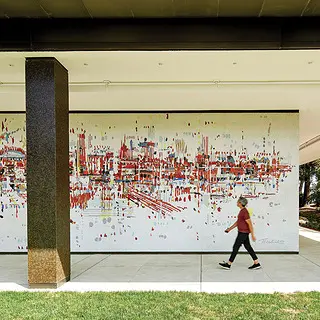
A Rare Tile Mural by Artist Wayne Thiebaud Gets Conserved
Wayne Thiebaud is famous for his paintings of everyday objects like cakes, lipsticks, and lollipops. But just a few years before he became an internationally known artist, he created a large-scale tile mural for the under-construction Sacramento Municipal Utility District (SMUD) headquarters in Sacramento, California. Called Water City and completed in 1959, the 3,650-square-foot mural was conserved in the summer of 2019 as part of an $83 million renovation of the International Style structure.
Albert Dreyfuss and Leonard Blackford, the building’s original architects, requested a piece that would wrap around the exterior ground floor. Thiebaud came up with a four-panel abstraction of a city reflected in water: one section each for the east and west walls, and two sections for the south wall, which contains the building’s main entrance. “In a sense, it’s kind of an early history of the development of Sacramento,” he says. He commissioned artisans in Italy to make glass tesserae (richly colored mosaic tiles) in variations of orange, red, blue, and white. The tiles were mounted on panels, which were sent to Sacramento and installed.

photo by: Bruce Damonte
Dreyfuss + Blackford Architecture oversaw the rehabilitation of the midcentury SMUD building in Sacramento, including the conservation of its Wayne Thiebaud tile mural.
Almost 60 years later, the firm that still bears Dreyfuss and Blackford’s names was selected to modernize the National Register–listed building. Dreyfuss’ son, architect Alan Dreyfuss of Wiss, Janney, Elstner Associates (WJE), managed the preservation aspects of the project. These included the conservation of the mural, which Dreyfuss calls “exceptionally important to the building.”
Though 12-foot overhangs had protected the mural through the years, it had a handful of damaged white tiles and needed a thorough cleaning. WJE used a gentle detergent to restore the tesserae’s natural luster and repaired tiles using identical ones salvaged from the building’s all-white rear wall. “It was very delicate work, because we had to match the grout. Otherwise, it would be glaringly obvious that the tiles had been repaired,” says WJE’s Kyle Normandin.
Water City is Thiebaud’s largest work, and with conservation now complete, his verdict is a thumbs-up. “They did a superb job, I think,” he says. “It looks almost new.”



